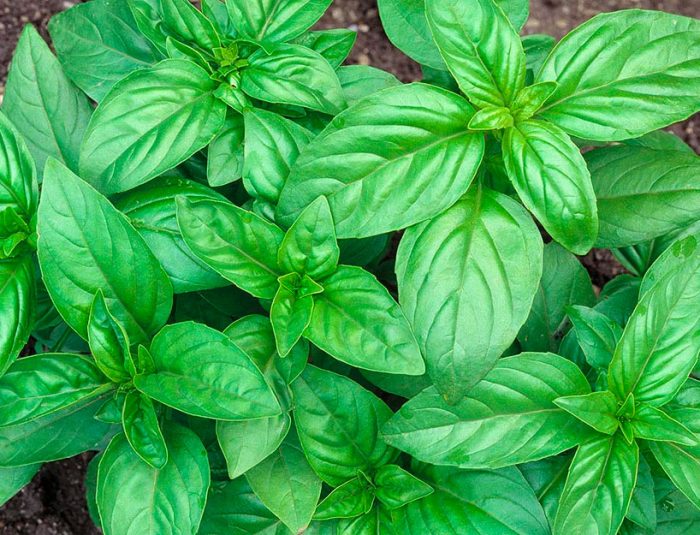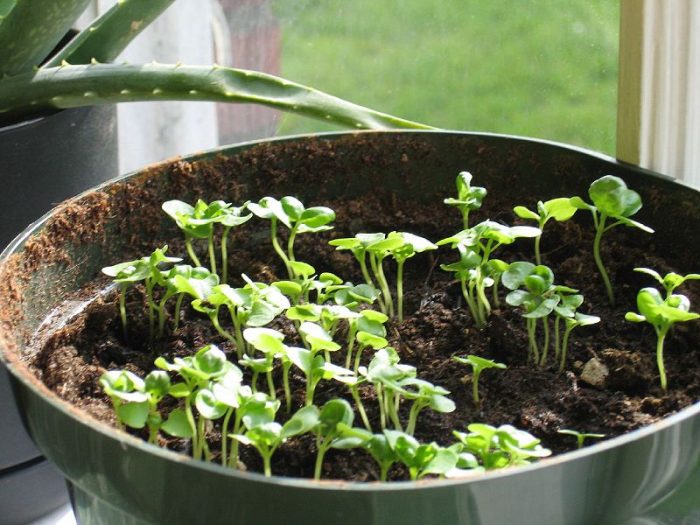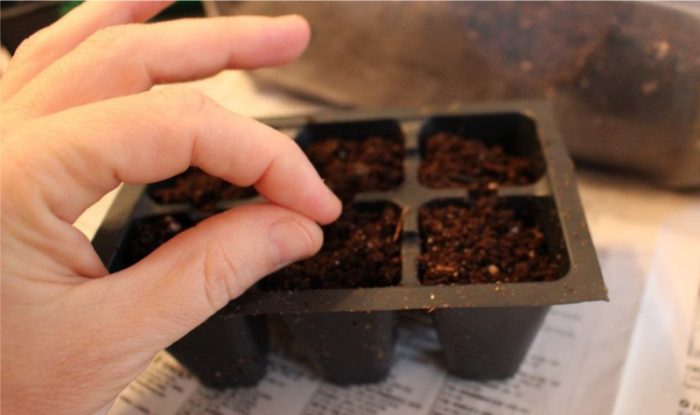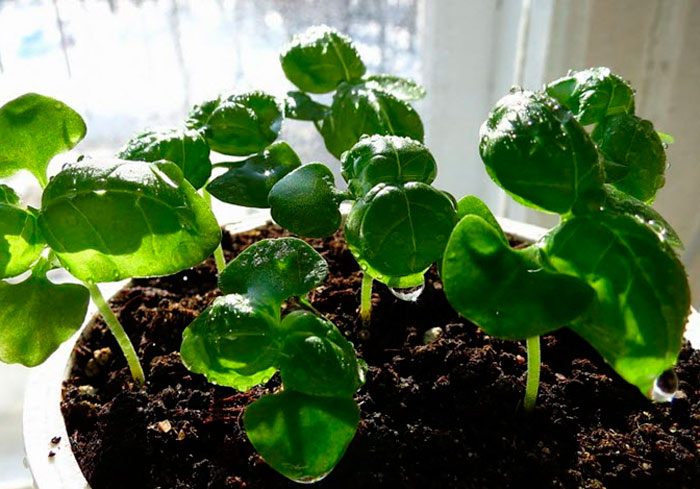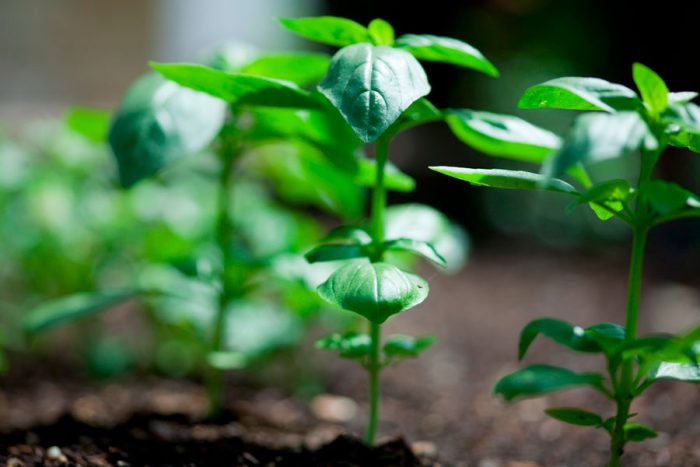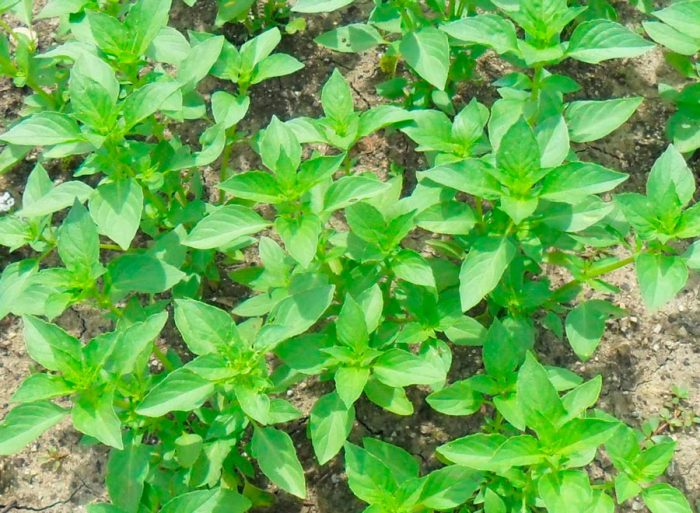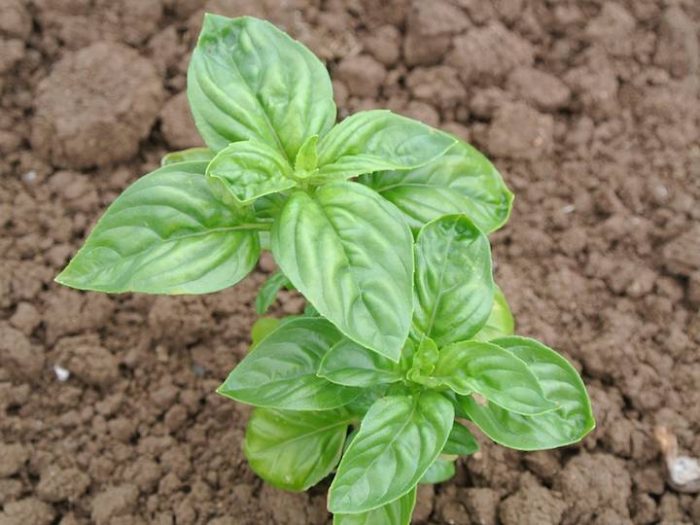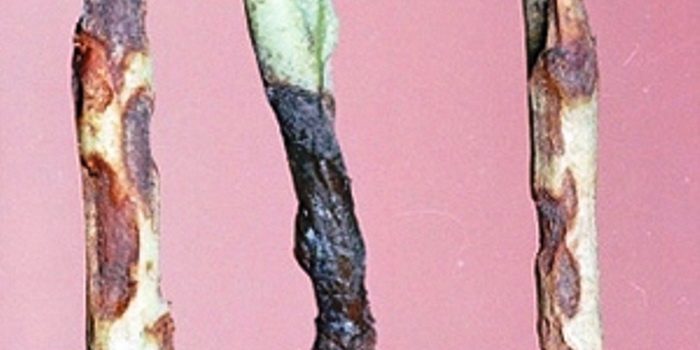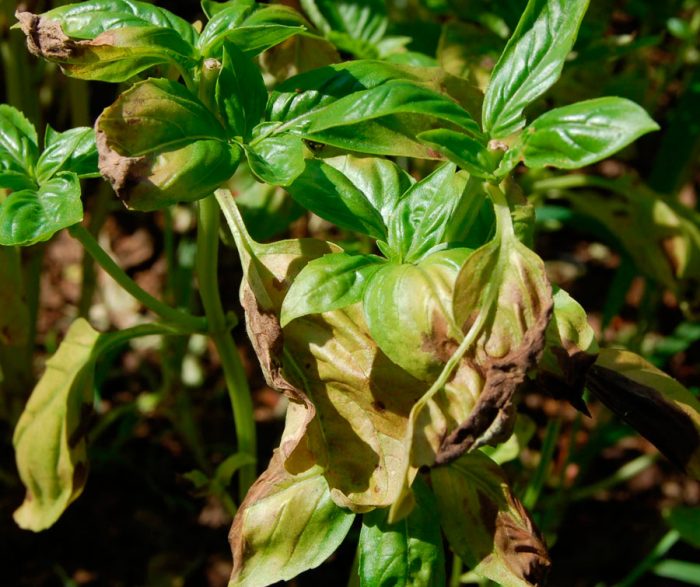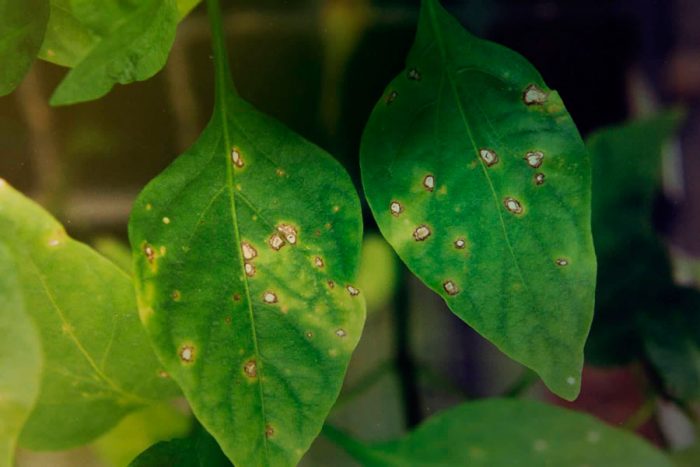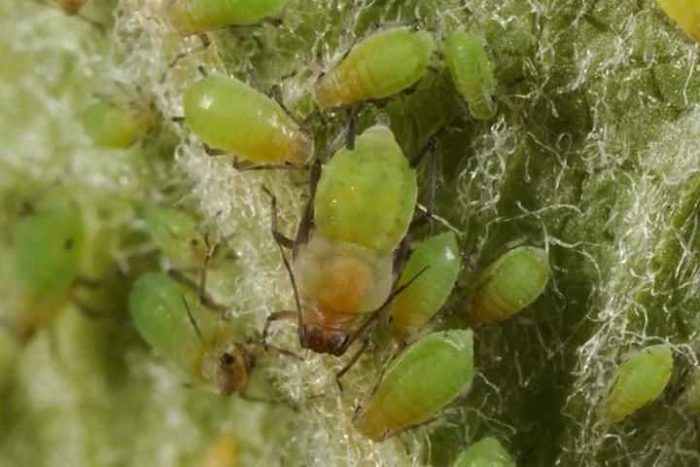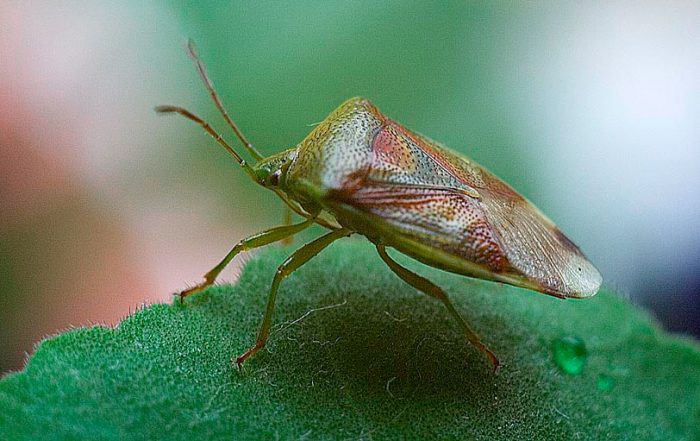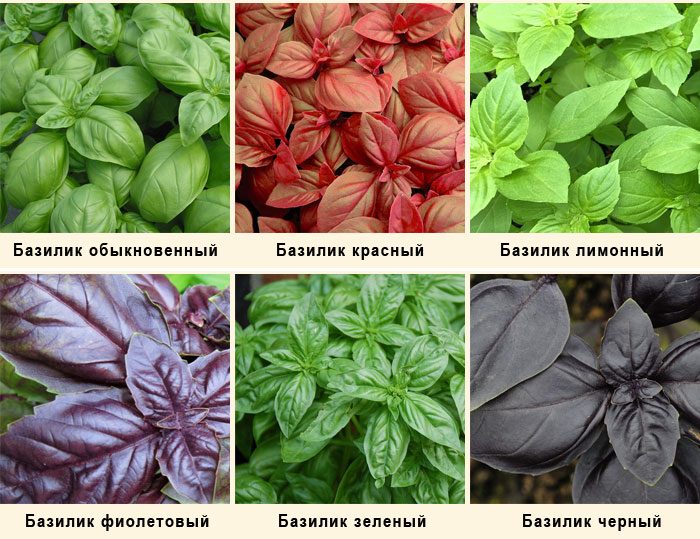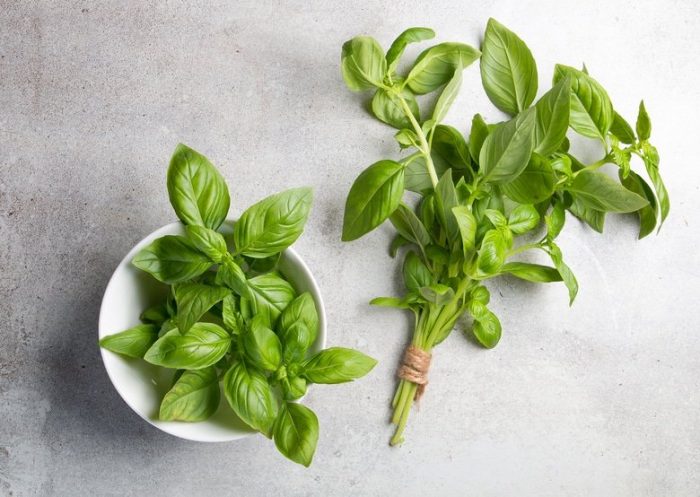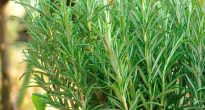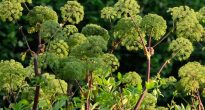A herbaceous annual plant, sweet basil (Ocimum basillicum), also called garden, or camphor, or ordinary, is a representative of the species Basil of the subfamily Cattle family of the Yasnotkovye family. In the wild, such a plant can be found in Iran, Africa, in the tropical regions of the American continent, in the Caucasus, in China, India, in southern Asia and in Central Asia. There is an opinion that the birthplace of the basilica is Africa, and it came to the territory of Europe thanks to the soldiers of the army of A. Macedonian. Previously, this culture was usually used as a medicinal plant. Today it is cultivated in almost all countries as a food spice.
Content
Basil features
Basil has a branching and superficial root system. The straight tetrahedral stem reaches 0.5–0.7 m in height, it is leafy and branched. Rarely toothed oblong-ovate leaf plates are short-petiolate. There are villi on the surface of foliage and shoots. Irregular whorls consist of axillary flowers of white, pinkish or purple color. The fruit contains nuts, which, after full ripening, are easily separated from each other. The seeds remain viable for 5 years.
The violet varieties of this plant have the strongest smell; they are very popular in the Caucasus and Asia. Green basil is most in demand in Europe, and it is also considered the most popular spice in Mediterranean cuisine. Before the bush begins to bloom, it begins to exude the strongest odor.
Planting basil seedlings
What time to sow
Basil can be grown either through seedlings or sown directly into open ground. However, most gardeners choose the first method, as it is the most reliable.
Sowing seeds for seedlings is carried out in the spring, it is recommended to do this from early to mid-April. For seeding, you will need a special soil mixture.To prepare it, it is necessary to combine humus, rotted compost and washed river sand, which should be taken in a ratio of 2: 4: 1. This substrate must be sieved, and then it is subjected to steaming in a water bath for 60 minutes. If you use ready-made soil mixture for sowing, which is sold in a store, then it will also need to be disinfected. To do this, it is spilled with a strong solution of potassium manganese or Fitosporin. For sowing basil, you can choose boxes, but in this case you need to be prepared for the fact that the plants will need a pick according to individual containers. Therefore, experts advise using cassettes for growing such seedlings, the depth of which should be 50–70 mm.
Sowing seeds is carried out in a wet substrate, while they are buried only 10 mm. The row spacing when sowing in a common box should be about 50 centimeters. Crops from above need to be covered with polyethylene or glass, after which they are removed to a well-lit and warm (20 to 25 degrees) place. The first seedlings can be seen 7-15 days after sowing.
Growing basil from seeds
As soon as the first seedlings appear, the shelter is removed from the container, and the plants themselves are rearranged to a cooler place (from 15 to 20 degrees). It is very simple to care for such seedlings. Watering should be carried out as needed, while it must be remembered that the substrate should not dry out, however, it is necessary to ensure that it is not waterlogged, since in this case such a fungal disease as a black leg may develop, due to which all seedlings perish. At the first signs of this disease, the plants will need treatment with a solution of copper sulfate (for 2 liters of water 1 tsp), or you can spill the earth with a strong solution of manganese potassium.
If basil was sown in a box, then during the growth of the first pair of true leaf plates, it will need to be dived. For this, a larger container is taken, which is filled with the same soil mixture, but only it will need to be fertilized. To do this, pour 2 tbsp into 5 liters of substrate. l. wood ash and 1 tbsp. l. complex mineral fertilizer. You need to plant the plants in a new container at the same depth that they grew before. After the seedlings take root and begin to grow, they should be pinched over a 6–8 leaf plate in order to stimulate the growth of lateral shoots. Plants begin to harden about 15 days before transplanting them into open soil. To do this, they must be taken out to fresh air every day. The duration of such a procedure should be increased gradually, so, you need to start from one hour, and at the end, the seedlings should be outside around the clock. Planting in open soil is carried out from mid to late May, but it should be borne in mind that return spring frosts should be left behind.
Growing basil on a windowsill
Growing rules at home
If you decide to grow basil on your windowsill, then it should be sown in the last days of February or the first days in March. For sowing, you need to use peat tablets or peat pots. It should also be noted that several seeds must be sown in 1 tablet or pot.
In this case, the seeds should be pre-sowed. To do this, they are immersed in a solution of potassium manganese of dark pink color, where they must stay for 2 hours. The crops should be covered with a material that should be transparent and breathable. They need to be kept in the same conditions as basil grown for seedlings (see above). It should be noted that such a plant needs sunlight for at least 3-4 hours a day. After the plants develop the first pair of true leaf plates, they must be transplanted.To do this, take a pot with a volume of 1 liter, at its bottom lay out a layer of drainage made of broken brick, expanded clay or small pieces of foam, its thickness should be from 20 to 30 mm. Basil should be planted with a pot or tablet. The soil mixture for planting is nutritious, it should also be water-permeable and light. For example, you can use this composition: combine coconut fiber and humus (2: 1). You can start picking the first leaves after 6 weeks.
How to water
Basil is a moisture-loving plant. In this regard, it is necessary to ensure that the substrate is slightly damp all the time. Watering should be done almost every day. If you forget to water the bush in time, then its leaves will very quickly lose their turgor. But in watering it is also very important not to overdo it, since due to stagnant liquid in the substrate, rot may appear on the root system. When the plant is watered, it is necessary to loosen the surface of the substrate in the container, do this with a frequency of 1 time in 2-3 days.
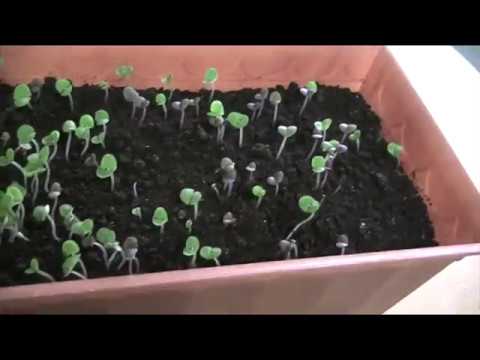

Watch this video on YouTube
Fertilizer
If a substrate that is not very fertile was used for planting this plant, then in this case it will need to be systematically fed. For top dressing, it is recommended to use universal fertilizers based on compost or humates, they must be added to the substrate in the concentration indicated in the instructions attached to the preparation. You need to feed the bush no more than 1 time in 4 weeks.
Growing basil outdoors
Landing in open ground
As mentioned above, it is imperative to plant basil seedlings in open ground from mid to late May, but you need to make sure that the spring return frosts are left behind. For landing, you should choose an open, well-lit area, which must be reliably protected from cold, strong winds. Some gardeners are advised to plant basil in the near-stem circle of a young fruit tree, there is practically no shadow from it, so the plant receives a sufficient amount of light, while its powerful spicy aroma can scare away various pests from the seedling.
The soil on the site should be light and saturated with humus, and it should also allow water to pass through well. 4 weeks before planting, the site should be digged, while peat, humus or compost should be added to the soil (for 1 square meter of the site 2 kilograms of organic fertilizer).
Disembarkation should be made in the evening or on a cloudy day. Prepare the holes, the distance between them should be from 15 to 20 centimeters. The grown seedlings should be planted in them. Planted plants need abundant watering, for this they use lukewarm, well-settled water.
Growing
Growing basil in open soil is easy enough. To do this, it needs to be watered, weeded, fed, loosened, and protected from pests and diseases in a timely manner. The planted plants that did not have time to take root should be covered with a film for the first 15 days at night in case of a sudden cold snap. Until the plant grows stronger and starts growing, it is recommended to systematically weed. During the season, it will be necessary to loosen the soil surface 7 or 8 times before watering. To stimulate branching, you must carefully break out the newly appeared flower stalks.
How to water
Watering the basil frequently will cause new leaf blades to grow much more intensively. Watering should be done immediately after the topsoil dries up. However, it should be remembered that excessive watering is just as unacceptable as insufficient, as it causes severe damage to the plant. It should be watered with lukewarm water (about 25 degrees), while it should settle for 24 hours (as long as possible).To make it more convenient to prepare water for irrigation, it is necessary to install a large container on the site in a well-lit place, for example, an unnecessary bath or barrel.
Fertilizer
To stimulate the growth of the green mass of the basil, you will need regular feeding, which is carried out 1 time in 4 weeks. The first feeding is arranged half a month after planting the seedlings on the site, for this they use a solution of Nitrofoski (for 12 liters of water a couple of large spoons of fertilizer). For 1 square meter of the plot, from 3 to 4 liters of the nutrient mixture should go.
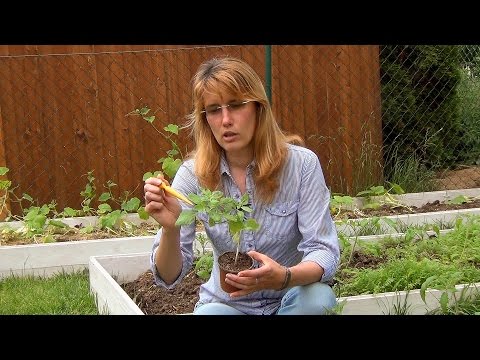

Watch this video on YouTube
What can you plant after basil
Experts advise against planting basil in the same area every year. It is necessary to alternate crops, which is the main principle of successful farming. If basil was grown on the same plot for 2 or 3 seasons in a row, then it will be possible to plant it in the same place only after 4 or 5 years. The area where basil was previously grown is suitable for planting plants that are resistant to diseases of this culture, for example, you can plant carrots, zucchini, pumpkins, tomatoes, legumes, cucumbers, squash and early potatoes. Basil is recommended to be planted after tomatoes, early and cauliflower cabbage, strawberries, siderates, onions, beets and herbs.
Basil pests and diseases
Diseases
Basil is highly resistant to various diseases. However, sometimes he still gets sick. Below will be described those diseases that this culture suffers most often.
Blackleg
Blackleg - basil seedlings are susceptible to this fungal disease. Its development is provoked by increased acidity, insufficient aeration of the substrate, as well as excessively frequent and abundant watering. The fungus affects the root collar of the seedlings, due to which the vessels that participate in the nutrition of the plant become clogged, the stem, as well as its base, soften, become black and thin, after which the bush begins to turn yellow and die.
Fusarium
Fusarium is also a fungal disease. Toxins are released into the nutritious juice of the diseased bush, as a result of which its vessels are affected. If a young bush is affected, then its shoots turn brown and gradually become thinner. In diseased adult plants, the top dries up, after which they wither and die. The disease develops actively at high temperatures, while the air humidity should be increased.
Gray rot
Gray rot - it most often affects plants grown in greenhouses or greenhouses. However, bushes grown in open soil can also be affected by this disease. At first, the disease manifests itself on the leaf plates located below, which have already begun to die off. After that, the disease gradually takes over the entire bush. Dry brownish specks appear on the infected parts of the plant, eventually becoming watery and covered with a gray fluff.
If the bush is affected by gray rot or fusarium, then at the initial stage of the development of such a disease, it should be sprayed with onion peel infusion. For its preparation, it is necessary to combine the husk with water in a ratio of 1: 4, the mixture should be infused for 24 hours. Before processing, the infusion should be filtered. If the seedlings are affected by a black leg, then the substrate in which it grows must be shed with a solution of potassium permanganate. In this case, diseased plants must be removed from the container along with a lump of earth and destroyed, and the resulting hole must be shed with a strong solution of manganese potassium. If the disease has already gained strength, then in this case, treatment with fungicidal preparations will be required, for example: Fitosporin, Toivita Jet, Fuedazol, Topaz and other similar actions.
To prevent basil from getting sick, certain preventive measures should be taken:
- you cannot grow this crop on the same site for more than three years;
- crops should not be too thick;
- Once every 7 days, dust the surface of the site with wood ash;
- water the plant on time, without flooding it or letting the soil dry out;
- loosen the surface of the site regularly;
- remove weeds when they appear.
Pests
This plant is also very resistant to pests, but field bugs and aphids can settle on it.
Aphid
Aphids are a very dangerous pest that can greatly harm the basil. It sucks out the juice from the shoots and foliage, which is why the leaf plates are curtailed, the development of shoots stops, and the bush itself begins to dry out. Such a pest leaves sugary secretions on the surface of the plant, on which a sooty fungus prefers to settle, due to which the bush becomes covered with a bloom of a dark color. In addition, this pest is considered the main vector of viral diseases, which are currently not treated. You should start fighting aphids immediately after finding it. It can be fought with folk remedies, for example, decoctions of wormwood, tansy, bitter pepper, dandelion, yarrow, onion, garlic, tomato or potato tops, mustard. It will take 2-3 treatments with an interval of 1-1.5 weeks if the crop is grown outdoors. A tool made from 100 grams of tar soap, crushed with a grater, and 1 bucket of water is considered quite effective. The ash solution also shows good results; for its preparation, it is necessary to mix 300 grams of wood ash with freshly boiled water, the mixture should boil for 30 minutes. When it settles, it is filtered, then so much water is added to the solution so that its volume becomes equal to 10 liters. If there are a lot of pests, then folk remedies may be powerless, in this case, the bushes are treated with Karbofos, while the solution must be done in accordance with the instructions. It should be noted that this insecticidal preparation is odorless and tasteless. So, Bankcol, Akarin and Aktellik are best suited for processing.
Meadow, or field bug
The field or meadow bug is also a sucking insect that feeds on the plant sap of this culture. As a result of its vital activity, deformation of the leaf plates occurs, specks of a whitish color are formed on their surface, then they become brown and gradually die off. Both larvae and adults of this insect can harm the basil. For wintering, such a bug settles in the upper soil layer or in loose leaves. To deal with bedbugs should be the same methods as with aphids.
Types and varieties of basil
The most commonly cultivated varieties of basil are camphor (or scented), Mexican (or cinnamon), purple (common or regan), and lemon (Thai). There are many varieties of this plant, which are distinguished by the following characteristics:
- Shades of smell... The aroma is tart, sweet, cold and warm. The main aromas of this culture are: cinnamon, anise, pepper, lemon, vanilla, caramel, clove and menthol. For the preparation of drinks, as well as desserts, those varieties are used that have a lemon, cinnamon, caramel and vanilla smell. Anise flavored varieties are good for fish dishes, while basil with pepper and clove aromas is suitable for meat dishes.
- Colour... There are green basil and purple basil. Purple varieties have a stronger aroma and are most commonly used in Central Asian and Caucasian cuisine. And green varieties are most popular in Europe, and in particular in the Mediterranean.
- The size and shape of the bush... Basil is divided into sprawling, compact, erect and semi-spreading. In this case, there are also intermediate forms.In height, tall (0.6-0.85 m), medium-sized (0.3-0.6 m), as well as low-growing (0.18-0.3 m) varieties are distinguished. For indoor cultivation, it is recommended to choose undersized varieties.
- Ripening terms... The varieties are divided into late, medium and early.
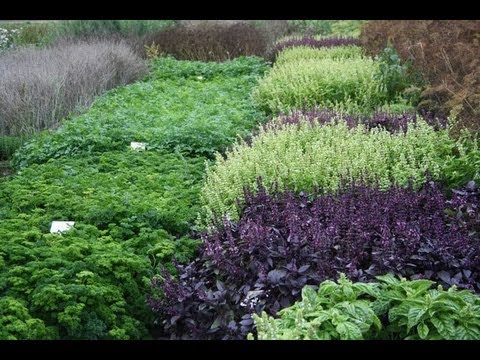

Watch this video on YouTube
The best varieties
- Mauritanian... This medium-ripening variety is distinguished by its productivity and aroma. The color of the sprawling erect bush is purple. Plant height is about 0.65 m.
- Table... The height of an erect bush is about 0.6 m. Large egg-shaped leaf plates are greenish and have a delicate texture. This productive variety is the most fragrant of all mid-late varieties.
- Dreamer... This variety is among the most productive. Sprawling massive bush has a bright green color. The shoots are branched, and the shape of the leaf plates is oval-lanceolate.
- Balconstar... This variety is undersized. Small fragrant leaf plates have excellent taste and are great for salads. It is often grown in pots on a windowsill.
- Genoese... This variety is distinguished by its yield. Large shiny dark green leaf plates are quite fragrant and have a pleasant taste. The leaves are used both dried and fresh. In some cases, they are substituted for mint, added to soft drinks.
- Gourmet clove... The variety is distinguished by its yield. The bush is medium-sized, erect and massive. Green leaf plates are medium in size and elliptical in shape. This variety is recommended to be used as a seasoning for meat, fish, cheese, rice and potato dishes.
- Basilisk... This compact variety grows well both in open soil and indoors. Has a peppery-clove scent. The height of an erect, densely leafy bush is about 0.2 m. Small leaf plates are green in color. The stems are half-raised.
- Yerevan... This variety is one of the most popular high-yielding varieties. This basil has a clove-peppery smell. On a medium-sized bush there are medium-sized leaf plates of an egg-shaped and purple color.
- Troll... This mid-ripening small-leaved variety is compact and productive. Great for indoor growing. Such a plant is not afraid of sudden changes in temperature. The foliage has a dark purple color. The plant looks very impressive.
- Magic Mountain... This Israeli variety is resistant to both low and high temperatures, and it is also drought tolerant. The neat bush has a round shape. Green leaf plates have a purple tint. Such a plant looks good in a garden plot as an ornamental one.
- Red Rubin... The variety was created by American breeders. The color of the bush is mahogany-purple. These plants use both foliage, which does not have the bitterness characteristic of green varieties, and buds (they are added to omelets).
The following varieties of basil are also quite popular: Sharm, Marquis, Ararat, Velvet, Violet, Greek, Robin Hood, Dragon, Gigolo, Green fragrant, Orion, Pepper aroma, Tempter, Baku, Sorcerer, Lemon, Dwarf, Curly, Philosopher, Broadleaf and etc.
Basil properties: harm and benefit
Benefits of basil
Basil has a specific smell, which is due to the presence of essential oil in the aerial part of the bush, which has a complex composition and antibacterial properties. Basil contains vitamins C, B2, PP, provitamin A, carotene, sugar, phytoncides, rutin.
It helps to strengthen the immune system, thereby increasing the resistance of the human body to infections. This plant has been proven to be able to keep the growth of HIV as well as cancer cells.It has antibacterial, tonic, antipyretic, antioxidant and tonic effect. Basil is recommended to be included in your diet for bacterial, viral and fungal infections, as well as pulmonary and respiratory diseases.
Such a herb will help get rid of excess gas in the rectum, excess slug in the nose, and it also helps to strengthen the nervous tissue and improve memory. It is highly effective against inflammation in the oral cavity: ulcers, plaque, caries, tartar and bad breath. Basil also has an astringent effect, it strengthens the gums, which helps to prevent tooth loss. It will help get rid of flatulence, as well as diseases of the gastrointestinal tract.
It contains enzymes that help accelerate the breakdown and burning of fat in the human body. And the Evengol and Estragol contained in it contribute to the stimulation of mental activity. This culture contains an essential oil that has a wound healing effect, it also eliminates spasms of a various nature and is used for inhalation of the upper respiratory tract. The juice obtained from the foliage is used to treat fungal skin lesions, and water extracts are used in the treatment of food poisoning and gastritis. Dried herb is used for making tea, as well as for making compresses that eliminate pain in the head area and manifestations of eczema. A tincture is prepared from this herb, which treats colitis, pyelitis, whooping cough, neurosis, bronchial asthma, low blood pressure, inflammation of the kidneys and bladder, flatulence and colds.
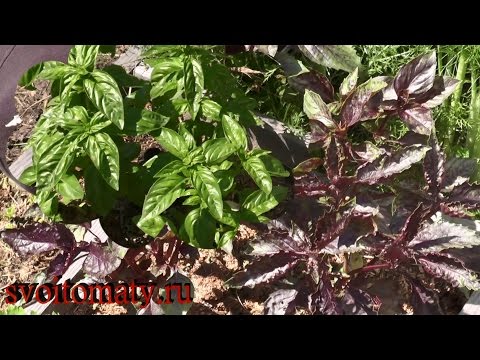

Watch this video on YouTube
Contraindications
This plant has a tonic effect on the body, so it cannot be used by people with diseases of the cardiovascular system (hypertension and hypertension). This is especially true for people who have had myocardial infarction. Basil is also contraindicated in thrombophlebitis, diabetes mellitus, vein thrombosis of the lower extremities and vegetative-vascular dystonia. As for hypotensives, they can use this herb without fear.
Experts do not advise pregnant women to consume large amounts of basil, especially the purple varieties. Moreover, during breastfeeding, it can be used, especially since it is an excellent lactogonic agent. But it should be borne in mind that because of it, milk will acquire an unusual taste and aroma, which may not please the baby. In excessively large quantities, this plant is not recommended for anyone, because it contains a little mercury.


